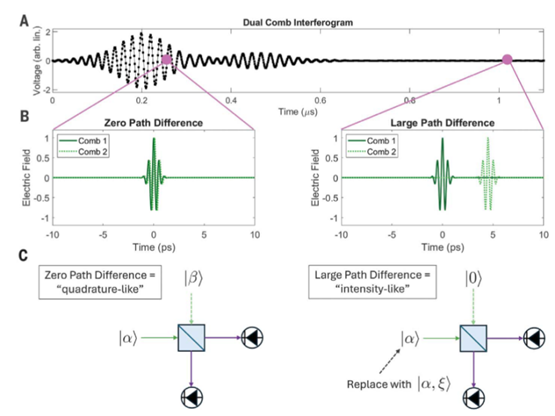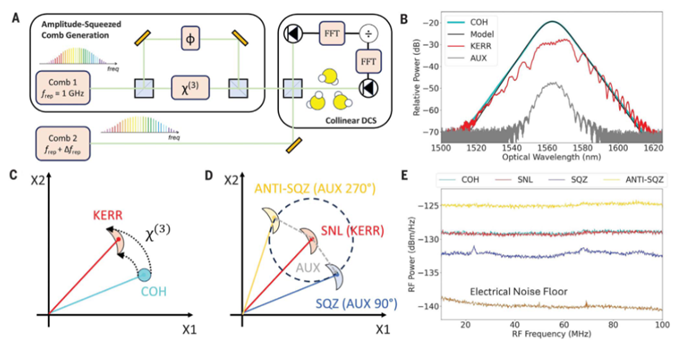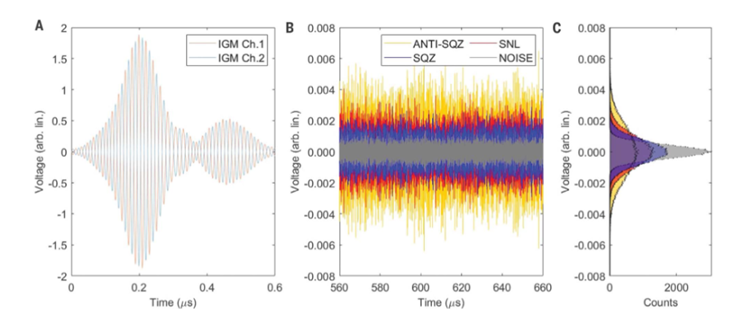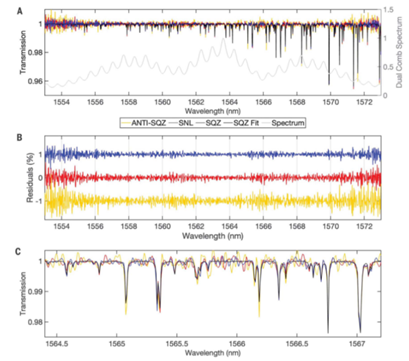Revolutionizing Ultrafast Nonlinear Optical Technology: Quantum-Enhanced Dual-Comb Spectroscopy
![]() 08/08 2025
08/08 2025
![]() 693
693
The versatility of optical frequency combs in broadband, high-resolution spectroscopy and precision measurements has propelled advancements in biochemical sensing, quantum system measurements, and numerous other domains. Currently, the measurement accuracy of optical frequency combs has attained the quantum noise limit, with the potential for further enhancement through the integration of quantum squeezing technology. While squeezed light combs have demonstrated significant effects in continuous-wave laser measurements, their metrological benefits in spectroscopy remain unverified.
Recently, a research team led by Scott A. Diddams at the University of Colorado, USA, significantly elevated the measurement accuracy of optical frequency combs in spectroscopy through quantum squeezing enhancement technology. This breakthrough surpasses the traditional shot-noise limit and demonstrates that compressing only one optical frequency comb can yield advantages. Leveraging the Kerr effect in nonlinear optical fibers, the team achieved amplitude squeezing of a 1 GHz frequency comb with a squeezing factor exceeding 3 dB, spanning a bandwidth of 2.5 THz. Concurrently, they generated mode-resolved spectra of hydrogen sulfide gas with a signal-to-noise ratio nearing 3 dB, outperforming the shot-noise limit. This reduction in quantum noise doubled the quantum speed of gas concentration determination, providing a theoretical and experimental foundation for achieving greater quantum advantages in broadband frequency comb metrology and spectroscopy in the future [1].

Figure 1. Time-domain quantum measurement image of dual-comb interferometry [1]
When dual optical frequency combs (DCS) detect molecules, molecular absorption manifests as dips in the radio-frequency comb spectrum and free induction decay (FID) signals subsequent to the interferogram. By mitigating technical noise sources such as detector noise and thermal noise, shot noise from coherent states emerges as the primary uncertainty factor in measuring the mode amplitude of optical frequency combs. DCS time-domain interferometry can be classified into zero optical path difference (OPD) regions and large OPD regions. As depicted in Figure 1, in the zero OPD region, optical pulses from the two combs temporally overlap, resulting in a mode-matched measurement that encapsulates information about the OFC spectral envelope, akin to the "quasi-orthogonal" measurement produced by the interference of two coherent states on a beam splitter. Conversely, in the large OPD region, the two pulse sequences are temporally separated, with FID noise dominated by shot noise, resembling the interference of a coherent state with a vacuum state on a beam splitter, exhibiting "quasi-intensity" measurement characteristics. In scenarios of minimal absorption depth and loss, employing a single amplitude-squeezed comb can reduce shot noise in the large OPD region.

Figure 2. Diagram of the dual-comb setup and the concept and results of single-comb squeezing [1]
The quantum-squeezed dual-comb (Figure 2(A)) is generated by two femtosecond lasers with a repetition rate of 1 GHz and a center wavelength of 1563 nm, phase-locked to the same optical reference to ensure mutual coherence. One of the combs is compressed to 260 fs and split into a strong pulse and a weak auxiliary pulse at a power ratio of 10:1, which are coupled to the orthogonal polarization axes of a nonlinear optical fiber. The strong pulse undergoes intensity-dependent phase shifts due to the Kerr effect, producing a bright amplitude-squeezed state. In phase space, this transforms the uncertainty of the coherent state into a crescent-shaped squeezed noise distribution (Figure 2(C)). Since the Kerr effect adheres to photon number conservation, by slightly displacing the Kerr state through the recombination of the strongly squeezed pulse and the weak auxiliary coherent pulse (with an adjustable phase shift) on a variable beam splitter with a power ratio of 100:1, the squeezing angle shifts, enabling the observation of quantum noise reduction or amplification in intensity measurements. The experiment measured up to 3.8 dB of squeezing and 4.0 dB of anti-squeezing near 45 MHz, achieving over 3 dB of squeezing across a broad frequency band of 10 MHz to 100 MHz, demonstrating the potential of broadband intense light squeezing in DCS applications.

Figure 3. Time-domain data of dual-comb [1]
The experiment utilized collinear quantum-enhanced dual-comb to generate interferograms between an amplitude-squeezed optical frequency comb (~15 mW) and a weak coherent state optical frequency comb (~10 mW). Despite the power imbalance, the quality factor of the dual-comb spectral data is comparable to the current state-of-the-art. The time-domain interference results are illustrated in Figure 3. Apart from a 180° phase difference, the interferograms generated by the two squeezed states closely align, with the quantum noise of the squeezed state (SQZ) reduced by approximately 55% (2.6 dB) compared to the shot-noise limit. Considering the electrical noise floor of the high-speed digitizer, the squeezing level is 3.5 dB, confirming the efficacy of single-comb squeezing in dual-comb spectroscopy.
The research team also detected the comb-mode resolved spectrum of hydrogen sulfide (H2S) gas through the quantum-enhanced dual-comb system (depicted in Figure 4). Within a coverage bandwidth of 20 nm, there are 67 vibration-transition spectral lines of H2S. The residual standard deviation of the squeezed state is reduced by 2.9 dB, lowering the uncertainty of concentration determination and achieving approximately a 2-fold quantum speedup with a resolution limit of approximately 50 MHz, satisfying the requirements of various applications.

Figure 4. Transmission spectrum and fitting results of dual-comb [1]
This paper innovatively combines quantum squeezing enhancement technology with optical frequency comb technology, achieving a precision breakthrough beyond the quantum shot-noise limit for the first time in broadband dual-comb spectroscopy measurements. It realizes collinear quantum-enhanced mode-resolved dual-comb spectroscopy over a 2.5 THz bandwidth with a quantum squeezing ratio of 2.9 dB. The metrological benefits of squeezed light combs in spectroscopy were validated through hydrogen sulfide gas, paving the way for the next generation of ultra-sensitive, high-speed spectral sensing technology.
References:
[1] Daniel I. Herman et al., Squeezed dual-comb spectroscopy. Science 387, 653-658 (2025). DOI:10.1126/science.ads6292.







